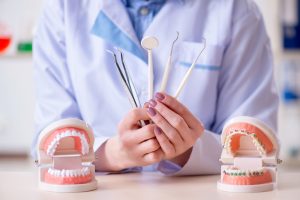Please note we may not offer this service at our office. Contact (715) 646-2161 for more information.
Your Guide to Pulpotomy Treatment
Pulpotomy is a word that may sound intimidating to parents whose children need dental treatment. This procedure treats decay in baby teeth and prevents further damage. Pulpotomy is an endodontic treatment that focuses on preserving the healthy part of a tooth’s pulp and removing the infected portion.
Discover more about this pediatric dentistry procedure with our Centuria, WI dentist, Dr. Georgie Vargas at River Birch Dental, by calling (715) 646-2161.
What Is Pulpotomy?
A pulpotomy is a dental procedure that removes infected pulp tissue from a child’s tooth while preserving as much of the healthy pulp as possible. The pulp is the soft tissue inside a tooth that contains blood vessels, nerves, and connective tissue. This is a more conservative alternative to pediatric root canal therapy for children having trouble with their primary teeth.
Pulpotomy procedures may also be performed on permanent teeth in specific cases where the pulp is damaged but the root structure is still healthy enough to support the tooth. However, root canal therapy is typically the preferred option for treating pulp-related issues in permanent teeth.
When Is a Pulpotomy Necessary?
A pulpotomy is usually necessary when a baby’s tooth is affected by tooth decay. The tooth typically has extensive caries that have affected the pulp in the crown of the tooth but have not yet reached the roots, and it causes pulpitis.
Pulpitis is inflammation of the pulp tissue and can cause pain, sensitivity to temperature, and difficulty eating. If left untreated, pulpitis can lead to the spread of infection to the roots of the tooth, which can cause an abscess, swelling, and pain.
The Benefits of a Pulpotomy
A pulpotomy has several benefits for children’s dental health, including:
 Tooth Preservation: By removing the infected pulp tissue and preserving the healthy tooth pulp, a pulpotomy can save a tooth from extraction. Primary teeth are essential for maintaining space for permanent teeth and aiding in speech and chewing.
Tooth Preservation: By removing the infected pulp tissue and preserving the healthy tooth pulp, a pulpotomy can save a tooth from extraction. Primary teeth are essential for maintaining space for permanent teeth and aiding in speech and chewing.- Pain Relief: Pulpitis can cause significant pain and discomfort in children. A pulpotomy can alleviate the pain by removing the source of inflammation and infection.
- Prevention of Infection: A pulpotomy can prevent the spread of infection to the tooth roots, which can lead to an abscess and swelling.
- Cost-Effective: Pulpotomy is a less expensive alternative to tooth extraction and can save parents money in the long run.
The Pulpotomy Process
Numbing the Area
The dentist will first numb the area around the affected tooth with a local anesthetic to ensure your child won’t feel any pain during the procedure.
Isolating the Tooth
They’ll isolate the primary tooth with a rubber dam to keep it dry and free of saliva and other contaminants.
Removing Damaged Tissue
They’ll then remove the decayed or damaged tissue from the pulp chamber of the tooth using special dental instruments.
Applying Medication
Next, the dentist will apply medication to the remaining healthy pulp tissue to help it heal and prevent further decay or infection.
Placing a Restoration
The dentist will fill the pulp chamber with a dental restoration material, usually a stainless steel crown, to protect the tooth and provide structural support.
Pulpotomy Aftercare
After a pulpotomy, follow the dentist’s instructions for proper aftercare to ensure that the tooth heals and remains healthy. Here are some tips for pulpotomy aftercare:
- Pain Management: Give your child over-the-counter pain relievers that are safe for children as directed by their dentist. Contact the dentist if the pain persists or becomes severe.
- Oral Hygiene: Encourage your child to brush their teeth at least twice a day and floss once a day to prevent further decay or infection.
- Eating Habits: Avoid giving your child hot or crunchy foods until the numbness from the local anesthetic has worn off completely. Soft foods are easier to eat and less likely to irritate the tooth.
- Follow-up Appointments: Attend all follow-up appointments as scheduled to ensure that the tooth is healing correctly and that the dental restoration material is still in place.
- Prescribed Medications: Ensure your child takes any prescribed medication or mouthwash as directed by their dentist.
Possible Risks and Complications
As with any other dental procedure, there are risks present and the possibility of complications occurring:
- Infection: The goal of a pulpotomy is to remove the infected or inflamed tooth pulp in the crown of the tooth to prevent further spread of the infection. However, if not all infected tissue is removed, or if bacteria are introduced during or after the procedure, an infection could still occur. Signs of infection include severe pain, swelling, pus discharge, and fever.
- Pain or Sensitivity: Post-procedural pain or sensitivity is quite common but typically subsides within a few days. Pain can be due to inflammation from the procedure itself or could indicate an infection. Sensitivity to hot and cold substances can also occur. If pain or sensitivity is severe or persists for more than a few days, contact your dentist.
- Bleeding: Some bleeding is normal immediately following a pulpotomy. However, if the bleeding is heavy or continues for more than a day, it may indicate a problem that should be reported to your dentist.
- Failure of the Procedure: A pulpotomy relies on the remaining dental pulp in the root of the tooth being healthy and free of infection. If this isn’t the case, the procedure can fail. Symptoms of failure may include pain, sensitivity, discoloration of the tooth, or an abscess forming at the root of the tooth. In such cases, a more extensive procedure, like a root canal or extraction, may be necessary.
- Allergic Reaction to Medication: In rare cases, patients can have an allergic reaction to the medicated dressing used during a pulpotomy. Signs of an allergic reaction include rash, itching, swelling, dizziness, and difficulty breathing.
- Tooth Discoloration: Sometimes, the medicated dressing used in the procedure can cause discoloration of the tooth.
- Injury to Surrounding Tissues: Although rare, there’s a small risk that the instruments used during a pulpotomy could inadvertently damage surrounding teeth, gums, or other oral tissues.
Frequently Asked Questions
A pulpotomy typically takes about 30 to 60 minutes to complete. This depends on the extent of the decay and the child’s cooperation during the procedure. Your dentist will provide a treatment timeline at your initial consultation.
A pulpotomy is similar to a root canal treatment but is typically performed on baby teeth. In a root canal treatment, the entire pulp chamber and root canal system of the tooth is removed and filled with dental restoration material. In a pulpotomy, only the infected pulp tissue is removed, and the remaining healthy pulp is left in place.
Yes. It’s recommended to place a dental restoration material, usually a stainless steel crown, after a pulpotomy to protect the tooth and provide structural support. The crown is placed over the remaining tooth structure and is cemented in place. The dental crown will also help prevent future decay or infection in the tooth.
